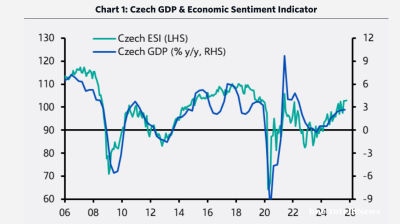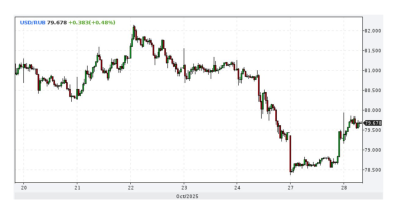The seasonally adjusted S&P Global Russia Services PMI Business Activity Index registered an extremely strong 55.4 in September, but was down slightly from 57.6 in August. Any result above the 50 no-change mark represents an expansion. (chart)
“Output at services firms increased for the eighth month running, with the pace of growth sharper than the survey average. Higher activity levels were often linked to a further uptick in new business and sustained improvements in demand conditions,” S&P Global said in a note on October 4.
The sister index, the seasonally adjusted S&P Global Russia Manufacturing Purchasing Managers’ Index PMI, was very strong at 54.5 in September from 52.7 in August, the sharpest improvement in operating conditions since January 2017. (chart)
Together the S&P Global Russia Composite PMI Output Index posted at 54.7 in September, down slightly from 55.9 in August. The latest data signalled a strong upturn in business activity across the Russian private sector. Manufacturers and service providers alike recorded a rise in output.
Russia’s economy has been doing remarkably well. Prime Minister Mikhail Mishustin said at a conference last week that “the worst is over” and hiked the forecast for growth this year again to 2.8%, although growing inflation and high interest rates are expected to slow the economy over the next three years somewhat.
Russia’s PMI indices show that on the ground business is flourishing on the back of heavy military spending that was increased in Russia’s 2024 budget to RUB10.8 trillion ($112bn) or 6% of GDP which has given industry a bump. Moreover, thousands of Russian soldiers returning home with large pay packages have also given a boost to consumption, which is apparent in the service sector PMI.
S&P Global’s September data indicated a strong rise in business activity at Russian service providers. Although expansions in output and new orders slowed on the month, the rates of growth remained sharp overall thanks to a sustained uptick in client demand. New export orders expanded at a survey-record rate, amid reports of successful outreach to new customers, S&P Global reports.
“Russian service providers recorded a steep rise in new orders during September. Despite easing slightly, the rate of growth was among the strongest in the past year. Firms attributed the increase to sustained customer demand and an expansion in client bases,” S&P Global said.
Concurrently, new export orders grew again and contributed to the rise in total new sales. The pace of expansion accelerated notably and was the sharpest on record (since September 2014). Companies stated that successful marketing led to a greater outreach to new customers, with demand conditions in some key export markets also improving.
Increased new business spurred firms to expand their workforce numbers in September. Employment rose for the second month running, but at only a fractional pace. Although businesses sought to broaden capacity, resignations reportedly hampered efforts.
Backlogs of work continued to grow, albeit at a softer pace, but the rate of job creation slowed notably to only a fractional rate. Resignations weighed on employment growth, despite firms' expectations for future output strengthening to the highest since May 2019.
Despite all the good news, Russia’s one economic problem remains elevated inflation, which was up to 5% in July. The ruble has also been weakening and crossed the important RUB100 to the dollar mark again on October 3 for the second time this year. The Central Bank of Russia (CBR) has been fighting back with first an emergency 350bp rate hike on August 15 and a second 100bp hike in July in September to tackle inflation and shore up the ruble’s value. As neither problem has been solved, the CBR is expected to put in another big rate hike at the October meeting. Taken together the rising interest rates are expected to cool the economy towards the end of this year and into next.
Price pressures across the services economy remained historically elevated. Exchange rate weakness and hikes in supplier prices pushed up input costs in September, according to panellists. The rate of input price inflation was the quickest since April 2022, with firms also reporting an acceleration in the pace of increase in charges to the fastest for 17 months.
Rates of input cost and output charge inflation slowed slightly, S&P Global reports. Input prices rose in line with higher wage bills, greater costs to service loans and exchange rate weakness. Although slower than that seen in August, the rate of cost inflation was the second-fastest since January.
Firms continued to pass through greater costs to customers where possible, through increased selling prices. The rate of charge inflation was sharper than the series average, despite easing to a three-month low.
A softer increase in employment belied stronger expectations among service providers of greater output over the coming year. Firms were their most upbeat since May 2019, with the degree of confidence above the historical average. Panellists stated that hopes of further upticks in new orders and planned releases of new service lines supported optimism. Business confidence picked up to the strongest since April 2019, which in turn supported a further rise in employment.
Data

Czech growth accelerates as domestic demand-side pressure builds
The Czech economy delivered an unexpected acceleration in the third quarter, marking a clear shift from its earlier position as a regional underperformer to one of Central and Eastern Europe’s fastest-growing economies.

Eurobonds of Istanbul-listed Zorlu units offer attractive yields amid rating downgrades and no default expectation
Debut paper currently offering 14-15% yield.

Ruble strengthens as sanctioned oil companies repatriate cash
The Russian ruble strengthened after the Trump administration imposed oil sanctions on Russia’s leading oil companies, extending a rally that began after the Biden administration imposed oil sanctions on Russia in January.

Russia's central bank cuts rates by 50bp to 16.5%
The Central Bank of Russia (CBR) cut rates by 50bp on October 24 to 16.5% in an effort to boost flagging growth despite fears of a revival of inflationary pressure due to an upcoming two percentage point hike in the planned VAT rates.




